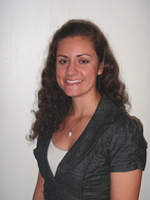
Name Riana Pryor
- Education Ph.D., Kinesiology (in progress), M.S., Exercise and Sports Science, B.S., Athletic Training and Exercise Physiology
- Target Audience Middle School

Getting injured is every athlete's worst fear, but what if getting injured could launch you into a wonderful career? For Riana Pryor, an unfortunate ankle injury in high school set her on a course that led to a career in athletic training and research. Find out how her injury gave way to her cool job!
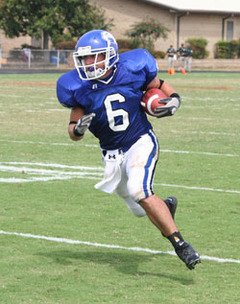 My job is to conduct research in both athletic training and exercise physiology. Here at the Korey Stringer Institute we focus on heat, hydration and preventing death in sports. We study how heat affects different athletes and due to the fact that heat can't dissipate out of football uniforms, we work mostly with football players, as well as triathletes. I conduct data collection and analyze research for the institute and I'm also involved with outreach efforts to share our findings with the general public. We also develop and help implement policy changes that help keep athletes safe. For example, when we discovered that heat acclimatization helps athletes perform better and decreased the chances of sudden death we created state-wide policies in high schools to ensure that they follow the proper protocol we discovered during our research.
My job is to conduct research in both athletic training and exercise physiology. Here at the Korey Stringer Institute we focus on heat, hydration and preventing death in sports. We study how heat affects different athletes and due to the fact that heat can't dissipate out of football uniforms, we work mostly with football players, as well as triathletes. I conduct data collection and analyze research for the institute and I'm also involved with outreach efforts to share our findings with the general public. We also develop and help implement policy changes that help keep athletes safe. For example, when we discovered that heat acclimatization helps athletes perform better and decreased the chances of sudden death we created state-wide policies in high schools to ensure that they follow the proper protocol we discovered during our research.
In high school I was a track and field participant and I broke my ankle in 2 places. I went to a few doctors and none of them could figure out what was wrong with me. Eventually, I decided I would figure out what was wrong with me. I went into athletic training in college and during my education I discovered what was wrong with my ankle. I then went to a specialist and asked if my diagnosis was right and while I was in surgery the surgeon confirmed that indeed my diagnosis was right.
When I broke my ankle I knew something had to change. I went to 17 different people to figure out what was wrong with me and no one knew. To me, that meant that something had to change to improve the diagnostic process and outcome for sports injuries. Someone had to do research to figure out better method of diagnosing, rehabilitating or preventing sports injuries altogether. So from there I decided to go into research so that I could question the existing diagnostic tools and athletic policies.
We get a lot of incoming calls at our office from athletic directors, coaches, parents and athletic trainers who are wondering about the policies at their schools and how to handle the situation properly if a student gets hurt. A lot of the questions we answer come from the public and we usually respond by sending our research to them and giving examples of how to implement our policies at their schools.
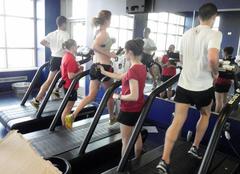 On an average day we may also be out in the field running our studies, or entering and analyzing data that we may have recently collected. When we conduct data collection out in the field we will often do things like go to a triathlon with a team of 10-15 people and we study 30-40 triathletes. Since we like to measure different variables over time, we will conduct baseline testing and follow-up testing. We conduct baseline testing by collecting blood samples, checking the participants' weight and handing out questionnaires to be completed by the athletes before the race. Then the athletes will go and complete the triathlon or marathon, and afterward we will check these things again. We may conduct these tests 2 or 3 more times in the days following the race.
On an average day we may also be out in the field running our studies, or entering and analyzing data that we may have recently collected. When we conduct data collection out in the field we will often do things like go to a triathlon with a team of 10-15 people and we study 30-40 triathletes. Since we like to measure different variables over time, we will conduct baseline testing and follow-up testing. We conduct baseline testing by collecting blood samples, checking the participants' weight and handing out questionnaires to be completed by the athletes before the race. Then the athletes will go and complete the triathlon or marathon, and afterward we will check these things again. We may conduct these tests 2 or 3 more times in the days following the race.
We also get a lot of inquiries from the press, as many newspapers want to interview us about what they can do in their city. We like to communicate with the press because the news networks help us spread the word about preventing sudden death in sports.
Right now there is big push for preventing Exertional Heat Stroke. Every summer there are high school and college athletes that die either because their coaches are pushing them too hard or because they are doing too many practices in the heat with all of their gear on. This especially happens in football because the uniforms worn by football players tend to trap heat close their bodies without allowing it to dissipate. The NCAA supports our recommendations for policies at the collegiate level, but since a national governing board does not exist at high school level we have to go state by state when we address policy issues and recommend changes.
We also recommend having an Automated External Defibrillator (AED) on site as well as an Emergency Action Plan. If something goes wrong every school needs to have a plan to outline who will take care of what - Who will call the ambulance? Where will the ambulance enter? Who will call the athlete's parents? These areas of responsibility should all be outlined in an Emergency Action Plan.
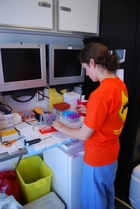 I have always liked sports, as well as subjects that were related to biology or anatomy. I always found it interesting to learn why the body acts a certain way. Anatomy was definitely my favorite class to take because I liked learning about all the different bones and muscles in the body. I really enjoyed the hands-on classes and when we were able to dissect things. It's probably obvious at this point, but I also enjoyed P.E. classes because I got to run around and play.
I have always liked sports, as well as subjects that were related to biology or anatomy. I always found it interesting to learn why the body acts a certain way. Anatomy was definitely my favorite class to take because I liked learning about all the different bones and muscles in the body. I really enjoyed the hands-on classes and when we were able to dissect things. It's probably obvious at this point, but I also enjoyed P.E. classes because I got to run around and play.
I think my biggest challenge was with the classes themselves. When I was studying to become a researcher I had to understand things like statistics, research methods, how to set up protocols, how to organize data - this stuff all came pretty easily to me. However, I found the in-depth physiology and biology courses at the college level to be very difficult. Biology in college is much more difficult than it is in high school. I always knew, however, that that once I understood the complicated materials I could apply all of that knowledge to sports and movement, so this is what motivated me to push though those tough classes.
Middle school kids should enroll in high school anatomy, physiology and biology courses. There are also a lot of different clubs you can join in high school. My high school had an anatomy club that visited doctor offices and observed surgeries. We could also shadow someone for a day, whether it was an athletic trainer or a physical therapist. Getting a real-world glimpse into the field helps you realize what you like and what you don't. Ultimately, these experiences will help you figure out if it's the right field for you.
My high school Track and Field coach, Kevin Carriero, was always very supportive of me. We had a really good relationship because he coached me for 5 years and had been with me the whole time I was dealing with my ankle injury. He would attend doctor's appointments with me, he would learn what I had to do to rehabilitate my ankle and he really knew what I was going through. He also always made sure I still felt like part of the team even though I was injured. When I was a senior in college I told him I was thinking about getting a Master's degree and his response was "of course you are getting a Master's, why wouldn't you get a Master's." Then when I was thinking about pursuing a Ph. D. he reacted the same way. He was very lighthearted about it, but very motivating as well.
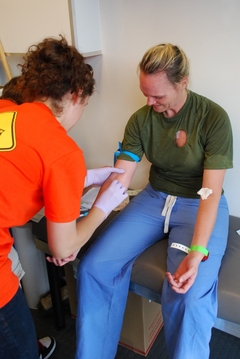 Get involved in sports and get used to the way your body moves and reacts to things. If you hurt yourself pay attention to how it feels and why it happened. Learn from any athletic trainer that may be around you. Also, study athletes! Watch them on TV, go to tournaments and races, and if you live in a town that has an Olympic Training Center, go visit it. You also may be able to shadow an athletic trainer at your local high school or with local club teams.
Get involved in sports and get used to the way your body moves and reacts to things. If you hurt yourself pay attention to how it feels and why it happened. Learn from any athletic trainer that may be around you. Also, study athletes! Watch them on TV, go to tournaments and races, and if you live in a town that has an Olympic Training Center, go visit it. You also may be able to shadow an athletic trainer at your local high school or with local club teams.
There are also a lot of museums that can help you learn about all the technology that has been created for the human body. Some museums also have biology workshops that rotate through. The traveling "Bodyworks" exhibit is also great because it allows you to see inside the human body.
I recommend taking athletic training courses (if your school has them), strength and conditioning, biology, anatomy, physiology and physics. Statistics is also good to take if you plan to go into research.
Are there exciting things happening in your field that could involve children who will enter the field in 10-15 years?
There is a lot of testing for performance enhancing drugs happening these days. They are constantly discovering new drugs that are performance enhancing and developing tests that can detect those drugs. This will definitely be a big issue in the future of this field. Also, if you are looking to make an impact on a large scale there are many policies, especially at the high school level, that need to be changed. These policies involve requiring AED's at every high school, coaching education and emergency action plans.
There is also a lot of genetic testing that is affecting this field. People are becoming able to look at a genome and see if someone is predisposed to everything from diabetes to the ability to run quickly. There is a lot of different technology popping up in this field such as portable MRI machines and smaller AED's.
Acclimatization: to adapt or become accustomed to a new climate or environment
Automated External Defibrillator: a portable electronic device that automatically diagnoses the potentially life threatening cardiac arrhythmias of ventricular fibrillation and ventricular tachycardia in a patient, and is able to treat them through defibrillation, the application of electrical therapy which stops the arrhythmia, allowing the heart to reestablish an effective rhythm.
Baseline: a basic standard or level; a specific value or values that can serve as a comparison or control.
Exertional Heat Stroke: Heat stroke is a serious medical emergency in which the body's cooling systems stop working and the core temperature can rise to dangerous levels. Exertional heatstroke (EHS) generally occurs in young individuals who engage in strenuous physical activity for a prolonged period of time in a hot environment.
MRI (Magnetic Resonance Imaging): A noninvasive diagnostic procedure employing an MR scanner to obtain detailed sectional images of the internal structure of the body.
NCAA: National Collegiate Athletic Association.
Physiology: the branch of biology dealing with the functions and activities of living organisms and their parts, including all physical and chemical processes.
(adapted from dictionary.com and wikipedia.com)
Abdul Yassine is a senior biology major and soccer player at Southern M…
Melissa Wallace is an SMU alumna who studied Mechanical Engineering. Sh…
Do you love music and science? Do you think you have to choose just one…